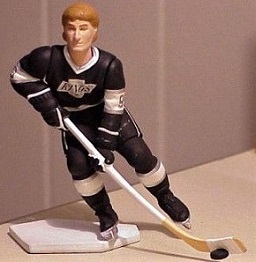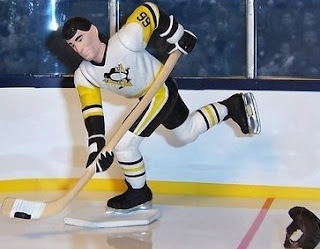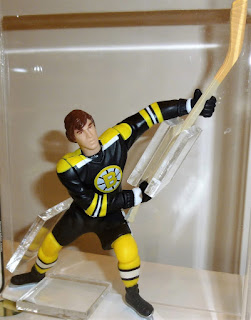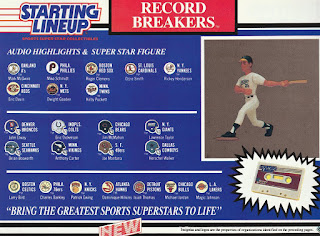1. Is there a price guide for SLU?
We have a Price Guide link on my page, you can also check eBay or Worthpoint for completed sales.
2. Is there a checklist for SLU?
We have a Checklist sorted by player, team, and year of release.
3. Can the figures be graded?
Yes, grading the package or just loose sports cards can significantly increase the value. There's a company called Action Figure Authority (AFA) that will grade unopened figures. They grade on three criteria including the plastic, cardboard, and figure quality. Note figures with yellow plastic will be designated as 'Y'. Also the loose sports cards can be graded by PSA which may turn out to be worth than the unopened figures if Mint.
4. How many different Starting Lineup's were made?
Nearly 4K different figures were made over the years featuring baseball, football, basketball, hockey, racing, golf, boxing & Olympic sports. We have a Picture Guide that shows every SLU made sorted by sport & year.
5. Which company produced SLU's?
SLU's were originally released in 1988 by Kenner which was owned by Tonka at the time. 1989 Tonka produced it's own European Soccer set. In the mid 1990's Hasbro bought Kenner and continued producing figures till 2001 when the line was discontinued. In 1997, Hasbro started producing a Winners Circle line in a joint venture with ACTION. After 2001, the ACTION company bought the rights to the Winners Circle name and continued the brand by itself. And in 2016 a company called Match-Up Promotions started producing the sports figures again as Stadium Giveaways.
6. Who Invented SLU?
Starting Lineups where the brainchild of former NFL player Pat McInally in 1987. Pat thought kids needed toys of real-life action hero's. As an homage to Pat, Kenner put his #87 in the shape of a football on the back of every package starting in 1988.
7. How are SLU's made?
The sculpting process for the initial prototype would begin at Kenner headquarters in Cincinnati. After the player & league approved, the final prototype would then be sent to China where the factory would make a small series of packaged & unpacked samples to be sent back to Cincinnati for final approval. Unfortunately not all figures would get approved resulting in a series of very rare & valuable unreleased figures that would never make it to the stores.
8. Can the 'yellow' tint be removed from the plastic or figure?
It's common for toy plastic to turn a darker color over time since they were intended as kids toys to open. For loose figures, usually exposing them to direct sunlight will reverse most the process and whiten the figures. Unfortunately there's no way to reverse the yellowing of the unopened plastic bubbles. Dark plastic packages are usually opened since the plastic will continue to darken and turn brittle over time.
9. How do you remove the price stickers from the figures?
Usually a hair dryer will melt the glue enough for the sticker to be removed from the package. Any residue left behind can be removed by Goo Gone Adhesive remover. This product also works well to remove paint marks from loose figures.
10. How do you spot counterfeit SLU's?
Unfortunately some folks will razor around the edge and lift the plastic enough to change out the card or figure in an effort to deceive. Usually there will be white line around the edge of the plastic if it's been re-glued. And it's almost certain if it's not pictured in our online picture guide then it's not authentic. There has also been an increase in counterfeit sports cards on eBay since grading as taken off. Our card guide also has pointers on how to spot these fakes.
11. Who is the most popular SLU?
According the Watchcount it would be Michael Jordan with the 1988 Bulls figure leading the charge. Honorable mention also goes to Kobe Bryant, Bo Jackson, Shaq O'Neil, and Ken Griffey Jr.
12. Who is the most commonly produced SLU?
That would also be Michael Jordan. An estimated 25-30K each where made of most figures with the 1991 jumping topping the list at nearly 50K!
13. Did they make any female figures?
They made 8 women... 1996 Nadia Comaneci, 1996 Florence Griffith Joyner, 1996 Jackie Joyner Kersee, 1996 Olga Korbut, 1997 Dottie Kamenshek, 1998 Bonnie Blair, 1999 Pepper Davis, 1999 Sheryl Swoops.
14. What is the rarest SLU?
Kenner auctioned off a series about 150 prototypes of different players for Charity at the Annual SLU convention. Each figure was a one of a kind prototype signed by Kenner executives accompanied with a Certificate of Authenticity. And it's no surprise that Nolan Ryan, Shaq, and Jordan sold for nearly $1,500 a piece!
15. Did they release any coaches?
They released three...1998 Vince Lombardi, 1999 Earl Weaver, 1988 Pete Rose(player/manager)
16. Can the plastic figures be reshaped if they're bent?
It's common for the plastic to bend to a such a degree that certain loose figures would fall over. The plastic can usually be reshaped by dipping the part that needs straightening in really hot water for 30 seconds while you reshape it, then dip in ice water to hold the form.
17. What is the most popular pose?
Some poses are so popular that they can command a premium. The 1988 Squatting QB is usually a collector favorite. It was produced in 1988 then discontinued. Other favorites include football Center, basketball Warmup, defensive Lineman, hockey Goalies, and Slam Dunk pose.
18. Are there any known errors in the line?
There are generally three type of errors. Packaging errors are the most common and the least valuable. The wrong sports cards were often mismatched with the figures or the figures packaged upside-down. There were also several Card errors where the players names were misspelled. Finally, Figure errors are the the rarest. Sometimes the wrong team torso or head was mismatched with the body since the figures were painted before they were assembled. The Most valuable include #44-Jackie Robinson, Red Sox-Chipper Jones, No beard-Patrick Roy, brown hair-Marciano.
19. Which sets are the rarest?
Just about all the rarest sets are foreign released. Very few figures made it back to the USA. And those that did where badly damaged...
1. 1989 French Soccer
2. 1988 Canadian Baseball
3. 1992 Argentina Soccer
4. 1989 Canadian Baseball
5. 1997 Upper Deck Basketball
6. 1998 Mexican Soccer
7. 1996 Basketball (Asian Edition)
8. 1998 Baseball (Japan Edition)
20. Which figure is worth the most?
This is a general list of nm.mt figures. Also note some are condition sensitive and very hard to find without dark yellow plastic as notes by 'clear plastic'.
1989 Eddie Murray $2,000-3,000
1989 Roger Staubach $2,000-3,000
1989 Bob Horner $1,500-2,000
1989 Bruce Hurst $1,500-2,000
1989 Steve Sax $1,500-2,000
1989 Julio Franco $1,500-2,000
1989 Rafael Palmeiro $1,000-2,000
1998 Eddie Jones $1,000-1,500
1996 Edwin Moses $1,000-1,500
1989 Bill Fralic $1,000-1,500
1996 Patrick Roy (No Beard) $1,000-1,500
1988 Karl Malone (clear plastic) $1,000-1,500
1988 John Stockton (clear plastic) $700-800
1995 Rocky Marciano (Brown Hair) $700-800
1994 Jackie Robinson (#44) $500-600
1997 David Robinson (Upper Deck) $500-600
1989 Fernando Valenzuela (Canadian) $500-600
1988 Mark Eaton $500-600
1988 Reggie Miller (clear plastic) $500-600
1988 Steve Jordan $400-500
1988 Marc Wilson $400-500
1989 Devon White (clear plastic) $400-500
1996 Magic Johnson (Asian) $300-400
1988 Tony Dorsett $300-400
1989 Sean Farrell $300-400
1990 Simon Fletcher $250-300
1992 Magic Johnson (Yellow Jersey) $200-300
21. Where can I find more information on SLU's?





















































